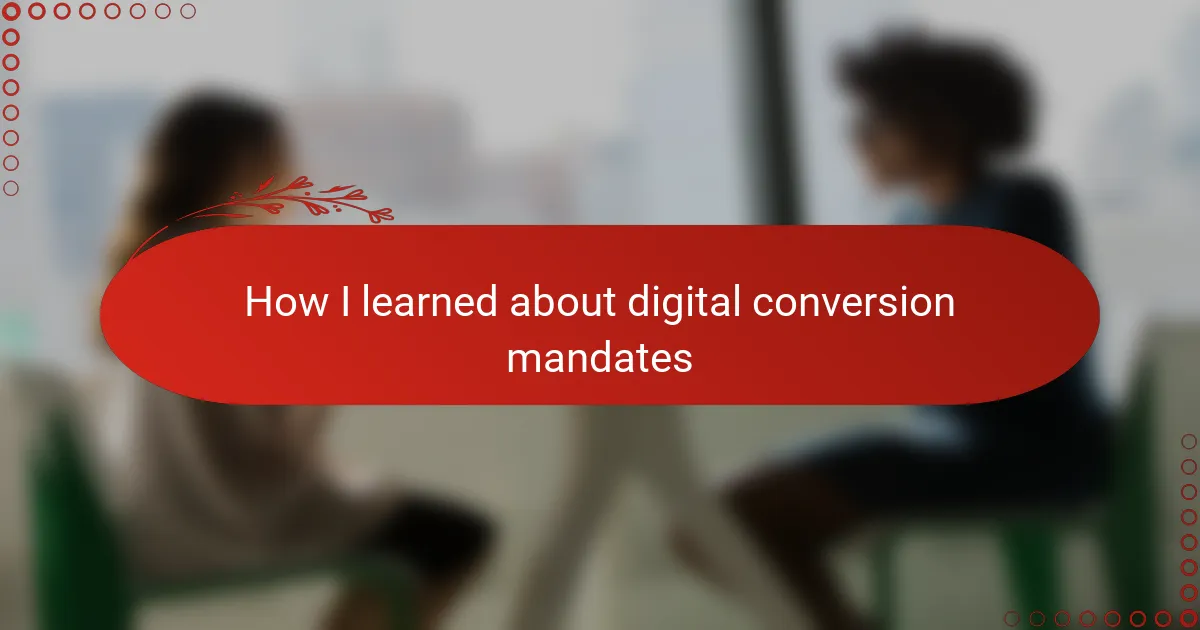Key takeaways
- Digital conversion in radio enhances sound quality and allows for interactive content, marking a significant shift from analog to digital broadcasting.
- Compliance with digital conversion mandates is crucial, driving innovation and keeping stations competitive, despite the challenges of costs and technical adaptation.
- Effective training and communication are essential for a smooth transition, as well as collaboration among team members to navigate the complexities of new technologies.
- Flexibility and patience are key lessons learned, helping teams to adapt and overcome obstacles during the transition process.

Understanding digital conversion in radio
When I first encountered the term “digital conversion” in radio, it felt like a foreign language. What does it really mean to convert a radio station from analog to digital? Simply put, it’s about transforming how audio signals are transmitted and received, moving away from old-school analog waves to cleaner, more precise digital streams.
I remember feeling overwhelmed, yet excited when I saw how digital conversion could improve sound quality and open new doors for interactive content. Have you ever wondered why some broadcasts sound crystal clear while others have that static buzz? That clarity difference is at the heart of digital conversion’s promise.
Understanding this shift made me appreciate the complexities behind every radio broadcast we casually tune into. It’s not just a tech upgrade—it’s a complete reimagining of how content reaches listeners, blending tradition with innovation in a way that feels both familiar and fresh.
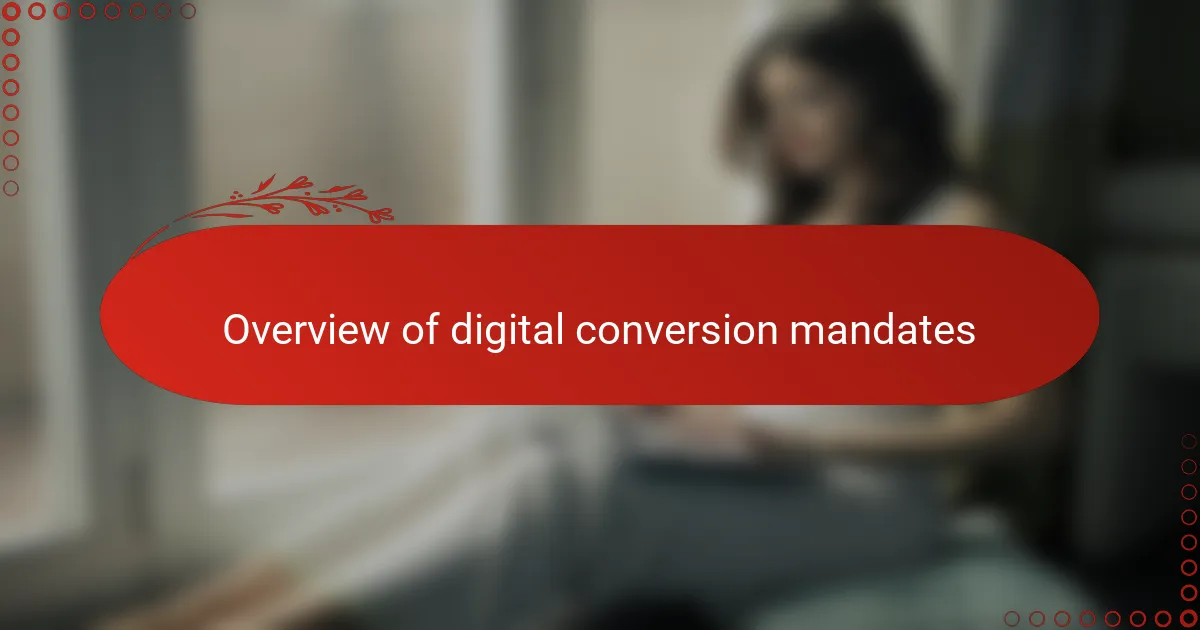
Overview of digital conversion mandates
Digital conversion mandates struck me as more than just technical rules—they felt like a massive push into the future of radio broadcasting. These mandates require broadcasters to switch from analog to digital transmission by specific deadlines, which I initially found daunting but soon realized how essential they are for progress.
At first, I wondered why governments and regulatory bodies would enforce such strict timelines. Then it clicked: without these mandates, the industry might drag its feet, leaving listeners stuck with outdated sound quality and limited features. I’ve seen firsthand how these deadlines create momentum, forcing stations to innovate rather than cling to the past.
Meeting these mandates isn’t just about compliance; it’s about embracing a new era. When I thought about the challenges stations face—costs, training, technical hurdles—I gained real respect for those who managed to meet the deadlines while still keeping their audiences engaged. It’s a tough but necessary leap.

Importance for radio broadcasters
For radio broadcasters, digital conversion isn’t just a technical checkbox—it’s a game-changer. I remember talking to a station manager who said, “Our listeners noticed the difference immediately; it was like upgrading from a flip phone to a smartphone.” That clarity and reliability mean everything when you’re trying to build and keep an audience.
But beyond sound quality, I’ve come to see how digital conversion opens up creative doors. Have you ever thought about how broadcasters can now offer interactive features, on-demand content, or even personalized ads? For those in the industry, this shift feels like unlocking a new toolbox full of possibilities.
Of course, the pressure to meet mandates can be intense. I’ve empathized with engineers scrambling to adapt equipment and learn new systems under tight deadlines. Yet, this urgency also sparks innovation and collaboration—something I find inspiring every time I hear a station successfully make the leap.
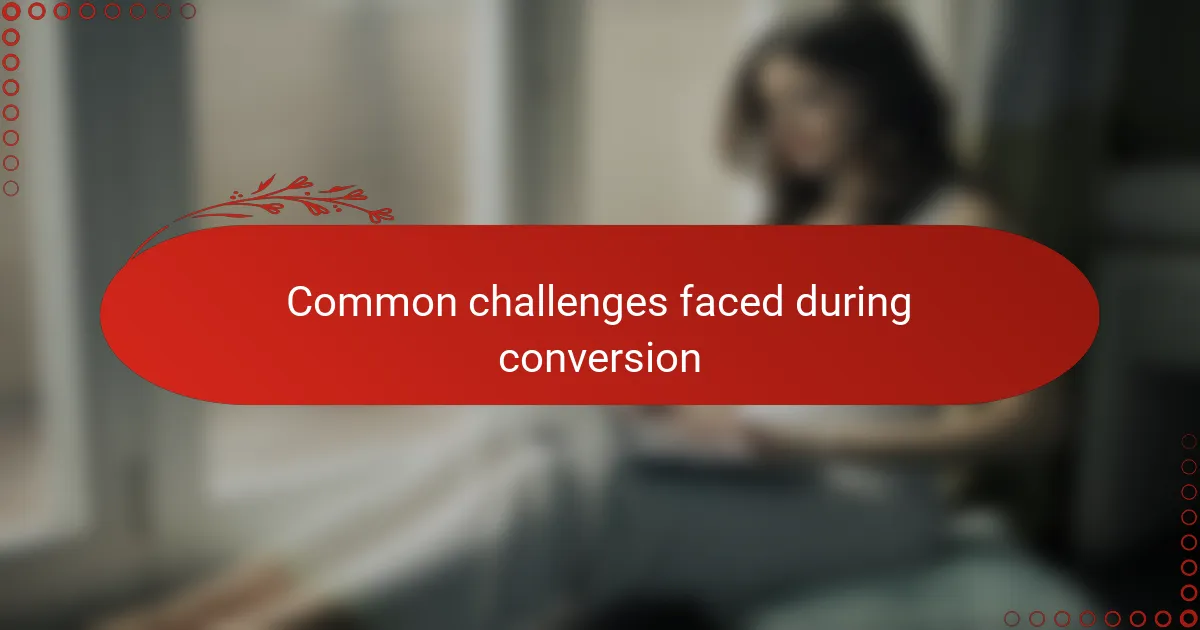
Common challenges faced during conversion
One challenge that surprised me early on was just how expensive the transition could be. I remember chatting with a technician who joked, “It’s like renovating a house while still living in it.” Upgrading equipment, retraining staff, and ensuring uninterrupted broadcasts all pile up costs in ways I hadn’t anticipated.
Another hurdle that stood out was the learning curve. I asked a broadcaster how their team handled new digital gear, and they admitted it was overwhelming at first—like switching from driving a manual car to an automatic in heavy traffic. Adjusting to new software, managing signal integrity, and troubleshooting unfamiliar issues tested their patience and teamwork.
Have you ever wondered how stations keep serving their loyal listeners during the switch? Balancing ongoing broadcasts with live system upgrades often meant sleepless nights and meticulous planning. I’ve come to realize that behind every smooth-sounding digital signal is a dedicated crew navigating these tough realities with commitment and grit.
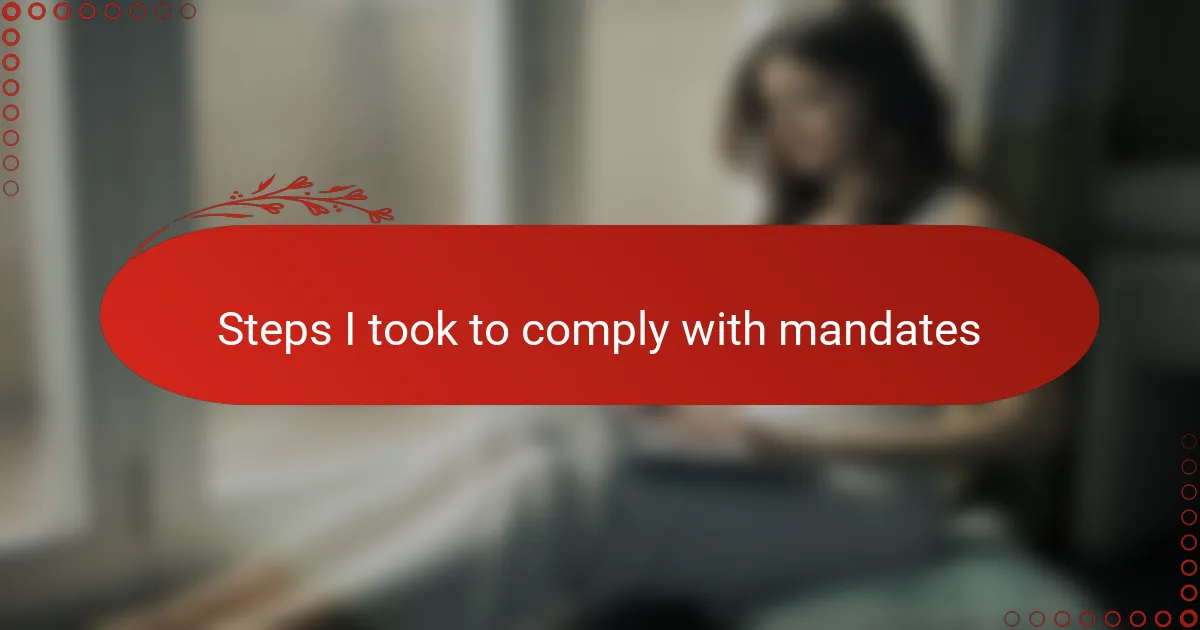
Steps I took to comply with mandates
The first step I took was conducting a thorough audit of our existing equipment to pinpoint what needed upgrading or replacing. It felt like peeling back layers of a very old system—some parts were surprisingly resilient, while others clearly belonged in a museum. Have you ever faced the challenge of deciding whether to fix or replace something? It’s tougher than it sounds when deadlines loom.
Next, I focused on training our team, because I knew that the best technology means little without skilled hands behind it. Organizing workshops and hands-on sessions made a big difference, even though some colleagues were initially skeptical or overwhelmed. Watching their confidence grow reminded me how vital support and patience are during such transitions.
Finally, I set up a step-by-step timeline to manage the switch without interrupting our daily broadcasts—a bit like juggling flaming torches while walking a tightrope. There were moments I doubted we’d pull it off smoothly, but careful planning and constant communication kept us on track. Have you ever been part of a project where timing was everything? This one certainly was.
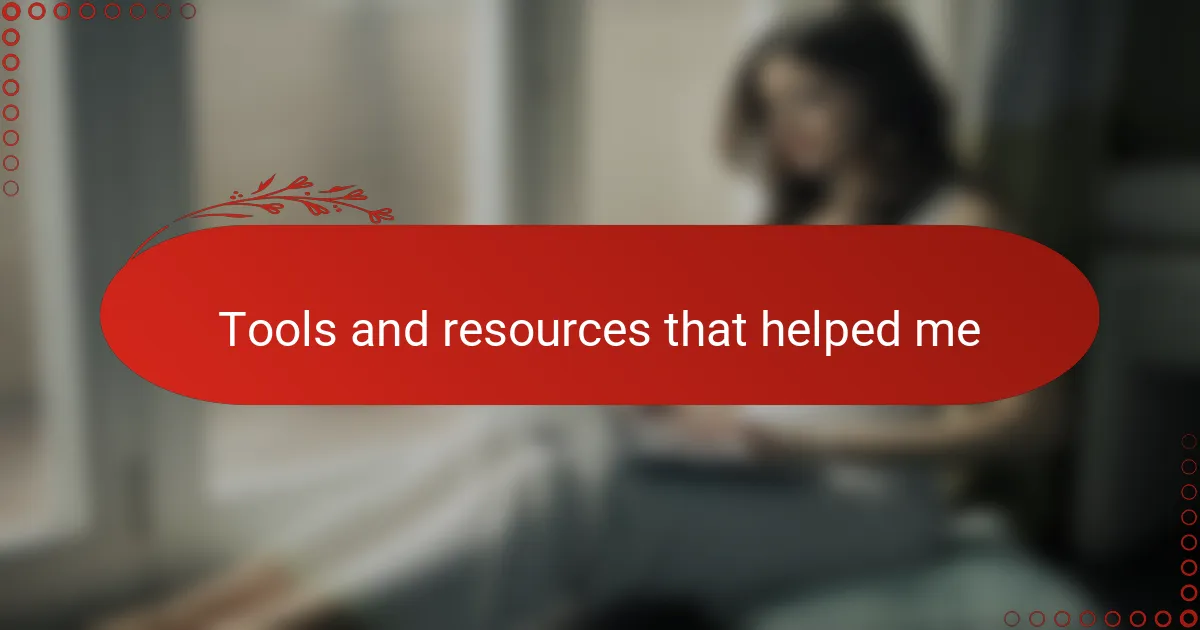
Tools and resources that helped me
One of the most valuable tools I leaned on was industry-specific forums and online communities. Joining discussions where engineers and broadcasters shared real-world experiences helped me grasp the practical side of digital conversion mandates. Have you noticed how getting insight from those who’ve been through the process can demystify technical jargon and reveal pitfalls before you encounter them yourself?
I also found government and regulatory websites surprisingly helpful. At first glance, their documents felt like dense legalese, but breaking down the mandates section by section made the requirements clearer. It was like piecing together a puzzle—slow at first, then suddenly everything clicks into place, and I could map out what needed to happen and when.
Lastly, hands-on webinars and training sessions were game changers. Watching experts demonstrate equipment setups and configurations gave me confidence that this digital leap wasn’t just theoretical. I remember feeling a mix of relief and excitement after completing my first session—knowing I had the tools and knowledge to guide others through the transition made all the difference.
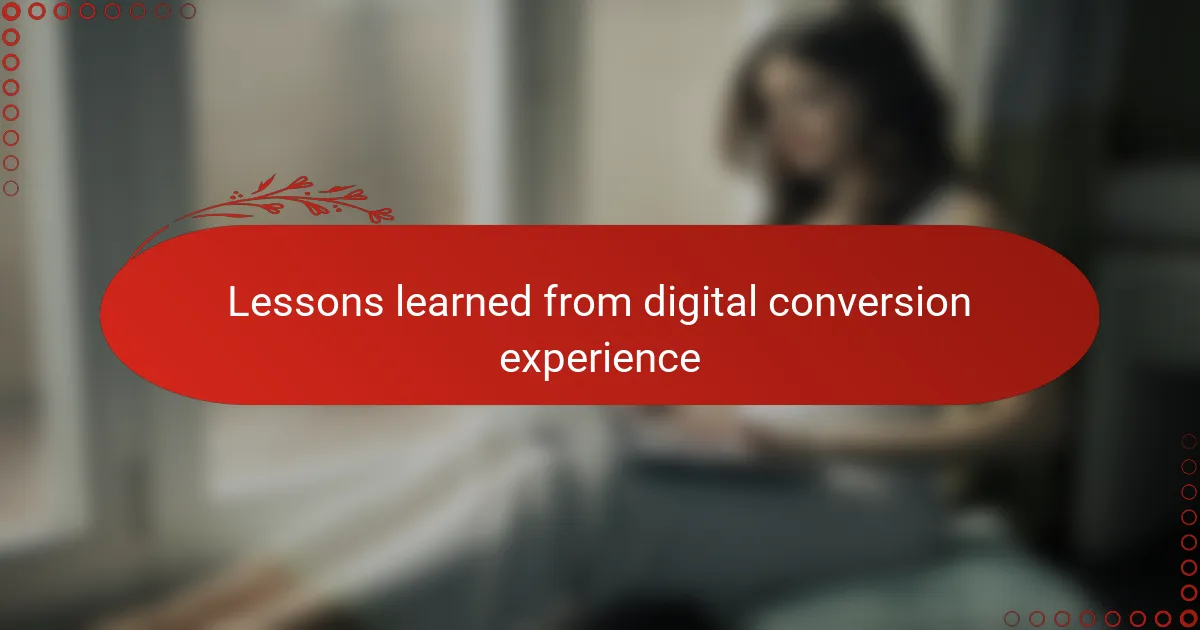
Lessons learned from digital conversion experience
What struck me most during the digital conversion journey was how vital patience became. Have you ever tried to learn something new under pressure? I certainly have, and I realized that rushing only led to mistakes. Taking the time to understand each technical step saved us from costly errors and built confidence across the team.
I also discovered that collaboration was a lifeline. Early on, I thought this was a solo challenge, but leaning on colleagues and industry peers transformed the experience. Sharing frustrations and solutions made the process feel less daunting—like we were all climbing the same mountain together, not isolated on separate paths.
Finally, I learned that flexibility was key. Plans don’t always go as expected, especially when juggling live broadcasts and new tech. There were moments of frustration, but adapting quickly kept everything moving forward. Have you ever witnessed how a small adjustment can turn a crisis into a success? That’s exactly what happened when we stayed open to change rather than sticking rigidly to our original timelines.
